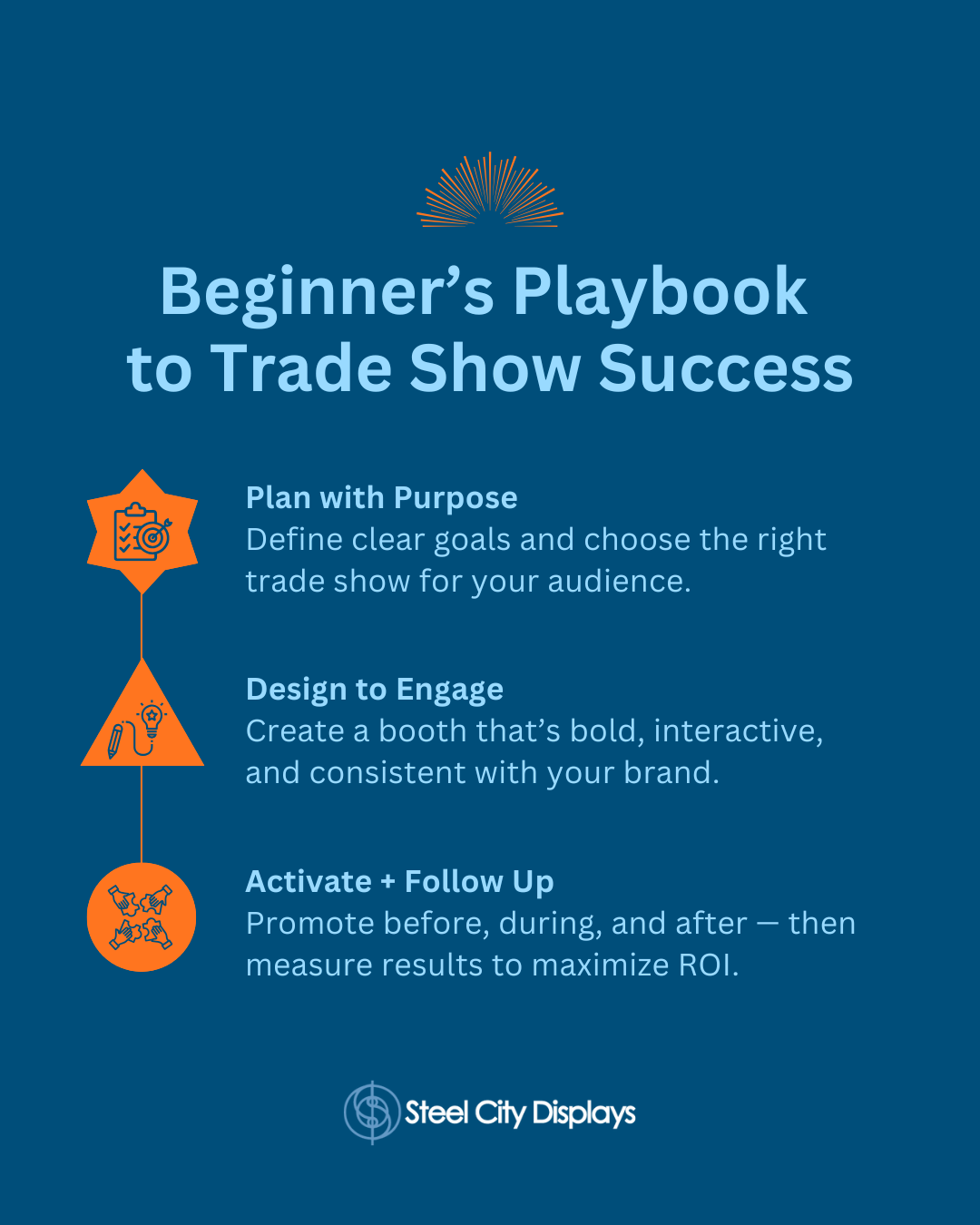A Beginner’s Playbook to Trade Shows: How to Get Started and Succeed
Trade shows can be one of the most powerful marketing channels for businesses of all sizes. They bring together industry leaders, prospects, and partners in one place — offering opportunities you can’t replicate online. But if you’ve never exhibited before, planning your first trade show can feel overwhelming.
A Beginner’s Playbook to Trade Shows: How to Get Started and Succeed
Trade shows can be one of the most powerful marketing channels for businesses of all sizes. They bring together industry leaders, prospects, and partners in one place — offering opportunities you can’t replicate online. But if you’ve never exhibited before, planning your first trade show can feel overwhelming.
This beginner’s guide will walk you through how to trade show successfully, from setting goals to designing your booth and following up afterward.
Why Trade Shows Matter
For many companies, trade shows are more than just events. They are a chance to:
Build brand visibility in front of a targeted audience.
Generate qualified leads by meeting prospects face-to-face.
Launch new products or services with impact.
Network with peers and partners to strengthen relationships.
The global exhibition industry generates billions annually, showing just how valuable these events are for business growth. In short, trade shows combine marketing, sales, and brand storytelling into one high-impact experience.
Step 1: Define Your Trade Show Goals
Before booking space, ask: What do we want to achieve? Common trade show goals include:
Growing brand awareness.
Collecting a set number of leads.
Meeting with existing clients.
Recruiting distributors or partners.
Driving sales of a new product.
Clear goals will guide decisions on booth design, staffing, and budget.
Step 2: Choose the Right Trade Show
Not every show is worth your investment. For beginners, research events by:
Audience fit – Does the show attract your target customers?
Size and reputation – Is it a leading event in your industry?
Location and logistics – Can your team easily attend?
Budget – Consider booth space, travel, shipping, and marketing.
Tip: Start with one or two smaller, niche shows before investing in major expos. Tools like the TSNN Trade Show Directory can help you compare options and find the right fit.
Step 3: Design a Booth That Attracts
Your booth is your brand’s stage. To stand out:
Focus on clear messaging. Visitors should know who you are and what you offer in seconds.
Use bold visuals. Large graphics, lighting, and digital displays draw attention.
Offer interactive elements. Demos, touchscreens, or product samples increase engagement.
Keep it consistent. Align booth visuals with your overall brand identity.
For inspiration, explore booth design trends from our Online Catalogue, a modular trade show display is cost-effective and flexible for different events.
Step 4: Promote Before, During, and After
Too many first-time exhibitors rely only on walk-by traffic. Instead, create a marketing plan:
Before the show: Send email invites, post on social media, and schedule meetings.
During the show: Use event hashtags, share photos and videos, and encourage visitors to tag you.
After the show: Follow up within a week with personalized emails and offers.
Looking for ideas? Steel City Displays offers insights on how brands amplify their trade show presence. Another incredible option for strategic marketing and event ideas is CDL Events. Remember: ROI depends not just on the event itself, but on how well you activate around it.
Step 5: Train Your Team
Your booth staff can make or break your success. Train them to:
Greet visitors warmly.
Ask open-ended questions to qualify leads.
Deliver quick, consistent elevator pitches.
Capture lead information efficiently.
A friendly, prepared team builds trust and keeps visitors engaged
Step 6: Measure and Improve
After the show, don’t stop. Review performance against your goals:
How many leads did you collect?
What was the cost per lead?
Which tactics worked best?
What could be improved for next time?
The Center for Exhibition Industry Research (CEIR) provides data and benchmarks to help exhibitors evaluate ROI and improve future strategies. You can also visit the Steel City Displays ROI Calculator to access an ROI calculation to assist you in budgeting and planning. Document lessons learned so your next trade show is even stronger.
Key Takeaways for Trade Show Beginners
Start with clear goals and the right show.
Invest in a booth that’s simple, professional, and aligned with your brand.
Promote before, during, and after to maximize ROI.
Train your team to connect, qualify, and follow up.
Learn from each show to grow your success.
Why a Partner Matters
For beginners, trade shows may seem intimidating. But with the right strategy, they become one of the most rewarding ways to build relationships and drive business growth.
At Steel City Displays, we believe in The Power of We standing shoulder to shoulder with you from strategy through execution. Whether you need a custom trade show booth, a modular display, or a permanent branded environment, our team is here to bring your vision to life.
From planning and design to logistics, installation, and post-show support, Steel City Displays is more than a vendor we’re your partner in creating consistent, measurable brand impact.
Ready to start your trade show journey? Explore how we can help at www.steelcitydisplays.com.

